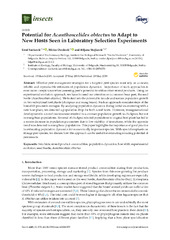Приказ основних података о документу
Potential for Acanthoscelides obtectus to Adapt to New Hosts Seen in Laboratory Selection Experiments.
| dc.creator | Savković, Uroš | |
| dc.creator | Đorđević, Mirko | |
| dc.creator | Stojković, Biljana | |
| dc.date.accessioned | 2019-06-04T10:06:30Z | |
| dc.date.available | 2019-06-04T10:06:30Z | |
| dc.date.issued | 2019 | |
| dc.identifier.issn | 2075-4450 | |
| dc.identifier.uri | https://www.mdpi.com/2075-4450/10/6/153 | |
| dc.identifier.uri | https://radar.ibiss.bg.ac.rs/handle/123456789/3357 | |
| dc.description.abstract | Effective pest management strategies for a targeted pest species must rely on accurate, reliable and reproducible estimates of population dynamics. Importance of such approaches is even more conspicuous when assessing pest's potential to utilize other stored products. Using an experimental evolution approach, we have focused our attention on a common bean pest, the seed beetle (Acanthoscelides obtectus). We looked into the potential to invade and sustain population growth on two suboptimal host plants (chickpeas and mung beans). Such an approach simulates steps of the host-shift process in storages. By analyzing population dynamics during initial encountering with a new host plant, we detected a population drop for both novel hosts. However, transgenerational development in a novel environment resulted in a constant population growth in chickpeas, but not in mung bean populations. Reversal of chickpea selected populations to original host plant has led to a severe decrease in population parameters due to low viability of immatures, while the opposite trend was detected in mung bean populations. This paper highlights the importance of good practice in estimating population dynamics for economically important species. With special emphasis on storage pest species, we discuss how this approach can be useful for estimating invading potential of pest insects. | en |
| dc.relation | info:eu-repo/grantAgreement/MESTD/Basic Research (BR or ON)/173007/RS// | |
| dc.rights | openAccess | |
| dc.rights.uri | https://creativecommons.org/licenses/by/4.0/ | |
| dc.source | Insects | |
| dc.subject | Acanthoscelides obtectus | |
| dc.subject | Bruchids | |
| dc.subject | Experimental evolution | |
| dc.subject | Host shift | |
| dc.subject | Population dynamics | |
| dc.subject | Seed beetle | |
| dc.subject | Stored product commodities | |
| dc.subject.other | m21 | |
| dc.title | Potential for Acanthoscelides obtectus to Adapt to New Hosts Seen in Laboratory Selection Experiments. | en |
| dc.type | article | en |
| dc.rights.license | BY | |
| dcterms.abstract | Стојковић, Биљана; Ђорђевић, Мирко; Савковић, Урош; | |
| dc.rights.holder | © 2019 by the authors. Licensee MDPI, Basel, Switzerland. | |
| dc.citation.issue | 6 | |
| dc.citation.volume | 10 | |
| dc.identifier.doi | 10.3390/insects10060153 | |
| dc.identifier.pmid | 31146407 | |
| dc.identifier.scopus | 2-s2.0-85068480784 | |
| dc.identifier.wos | 000475297300002 | |
| dc.citation.apa | Savković, U., Đorđević, M., & Stojković, B. (2019). Potential for Acanthoscelides obtectus to Adapt to New Hosts Seen in Laboratory Selection Experiments. Insects, 10(6), 153. | |
| dc.citation.vancouver | Savković U, Đorđević M, Stojković B. Potential for Acanthoscelides obtectus to Adapt to New Hosts Seen in Laboratory Selection Experiments. Insects. 2019;10(6):153. | |
| dc.citation.spage | 153 | |
| dc.type.version | publishedVersion | en |
| dc.identifier.fulltext | https://radar.ibiss.bg.ac.rs//bitstream/id/5050/Insects_2019_10_6153.pdf | |
| dc.citation.rank | M21 |

